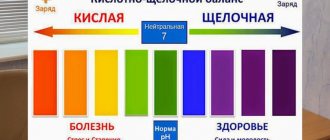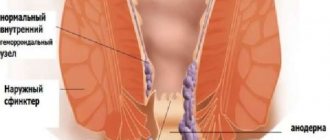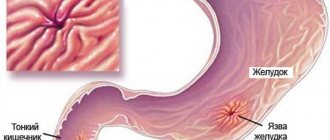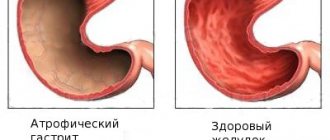Hemorrhoids are a disease based on the pathological condition of the corpora cavernosa of the rectum. It is accompanied by stagnation. According to research, more than a third of proctologist’s patients are seen specifically for hemorrhoids - this is a very common disease among men and women. Thus, Associate Professor Demin points out that “up to 10–15% of the adult population suffers from this disease” (Demin N.V., 2007, p. 2217).
Prolonged use of the toilet can cause stagnation of blood in the rectum or worsening stagnation. Straining, which a person suffering from constipation is forced to resort to, leads to even greater tension in the walls of the vessels in the anal area. This explains the development of hemorrhoids after constipation.
But there is an inverse relationship. Hemorrhoids are a disease that is accompanied by pain during bowel movements and bleeding. Therefore, a person may consciously refuse to go to the toilet and postpone defecation until the last minute.
The longer he restrains the urge, the more dense and compressed the feces become - emptying is more painful and difficult. Solid feces injure the mucous membranes of the rectum, and their accumulation leads to an even greater increase in pressure, so bleeding may increase.
A person finds himself in a vicious circle, the way out of which requires mandatory normalization of the process of defecation.
Causes of constipation and hemorrhoids
We found out that just as constipation can provoke hemorrhoids, and vice versa.
However, the cause of hemorrhoids can be not only constipation:
- Unbalanced, unhealthy diet. Associate Professor Vovk focuses on the fact that a possible cause of inflammation of hemorrhoids is constipation, “including with an unbalanced diet and a lack of plant fiber and extractive substances in the diet” (Vovk E.I., 2002, p. 73).
- Dysfunction of the rectum, which may be associated with psychoneurological, psychoemotional disorders, adhesive disease of the pelvic organs, etc.
- Venous circulation disorders associated with prolonged standing or sedentary work, bed rest, obesity, and frequent heavy lifting.
- Taking medications that interfere with the blood supply to the lower half of the body, varicose veins of the rectum.
- Pregnancy, childbirth.
Some authors attribute infections to one of the rare factors in the development of hemorrhoids, but this has not been proven. But it is known that frequent enemas, uncontrolled use of laxatives, and spicy foods can aggravate the problem.
There are two theories of the development of hemorrhoids: mechanical and hemodynamic. According to the first, increased intra-abdominal pressure plays a role, including during straining, leading to premature wear of the fixation apparatus: hemorrhoids enlarge and are removed from the anal canal.
The hemodynamic theory states that the cause of hemorrhoids is stagnation of venous blood due to a mechanical obstacle - hard feces.
Associate Professor Demin believes that “in the genesis of hemorrhoids, both mechanisms are equally involved” (Demin N.V., 2007, p. 2217). Predisposing factors include a lack of dietary fiber in the diet, lack of exercise, taking hot baths, careless lifting of heavy objects, etc.
Constipation - basic information
Constipation is a condition in which bowel movements are slow and difficult. As a result, pressure in the abdominal space and rectum increases. Accumulated feces impair blood flow in the blood vessels of the rectum and anal canal, causing hemorrhoids to form.
Some doctors claim that constipation is a disease, while others believe that it is a symptom of various pathologies. The risk group includes young children, patients over 55 years of age, pregnant and lactating women.
Normally, bowel movements occur 8 hours after eating. A healthy person visits the toilet from 3 times a day to 3 times in 7 days. Food is evacuated from the body through the intestines within 1 or 2 days. In this case, defecation does not cause discomfort, and the feces have a uniform consistency without impurities.
Symptoms of hemorrhoids with constipation
Severe constipation with hemorrhoids can aggravate the disease. Traditionally, there are two main symptoms of hemorrhoids. Professor L. A. Blagodarny presented the frequency of their occurrence in his study in the following values: “Bleeding (51%) and prolapse of nodes from the anal canal (37%), the frequency of which increases with increasing stage of the disease” (L. A. Blagodarny, 2005 , p. 117).
The following symptoms appear relatively less frequently:
- itching in the anus;
- mucus secretion;
- feeling of discomfort, pressure.
If inflammation of the hemorrhoids is accompanied by constipation, symptoms such as increased bleeding, pain during and after bowel movements, and a burning sensation occur.
It is important to understand that the longer the problem exists, the higher the risk of complications. They are characterized by specific manifestations.
Thus, with constant constipation, an intoxication syndrome develops, manifested by abdominal pain, nausea, and general poor health. With frequent bleeding, there is a risk of developing anemia - a person complains of dizziness, weakness, and drowsiness.
Specific symptoms of constipation include stool retention, the appearance of dense, fragmented, dry stool, abdominal pain and increased gas formation. Such manifestations accompany constipation outside of exacerbations of hemorrhoids.
It should be noted that both stool retention and bleeding are reasons for a thorough examination. Symptoms of hemorrhoids may be hiding a polyp or colorectal cancer. Therefore, it is important to see a doctor, undergo a colonoscopy, irrigoscopy or other studies that he prescribes.
Features of treatment
What to do if you experience constipation and hemorrhoids at the same time? The doctor will first suggest using remedies to relieve both conditions. It is important, first of all, to normalize the stool and cope with the acute symptoms of inflammation of the hemorrhoids.
Radical treatment of hemorrhoids is used; surgery is one of the most reliable methods. Surgery is recommended for stages 3 and 4 of the disease or active bleeding. The most common technique is ligation of hemorrhoids with latex rings.
Today, the Milligan-Morgan operation is widely used, in which three main groups of cavernous bodies are excised. In addition, the removal of hemorrhoids is carried out using modern technologies such as an ultrasonic scalpel.
Conservative treatment is indicated for stages 1 and 2 of the disease.
If the symptoms are acute, the doctor may prescribe the following types of medications:
- venotonics, phlebotropic drugs;
- sedatives;
- painkillers;
- hemostatics - hemostatic agents;
- anti-inflammatory medications.
Phlebotropic drugs are designed to increase the strength of capillaries and the tone of blood vessels, improve microcirculation, suppress inflammation, and reduce swelling. An integral part of complex treatment is the use of local remedies: suppositories, ointments, gels. They may have anti-inflammatory, analgesic, antipruritic or other therapeutic effects.
Treatment includes mandatory adherence to general recommendations: it is important to adjust your diet, avoid taking hot baths or visiting the bathhouse, and adhere to the rules of anal hygiene.
Of particular importance are the formation of bowel habits and work with the psycho-emotional sphere. Many people put off going to the toilet and deliberately suppress the urge to defecate, fearing pain.
This can cause complications, so it is important to take measures: for example, use a local anesthetic in consultation with your doctor. Make sure you have enough time for going to the toilet in the morning and for subsequent hygiene. This will help develop a useful reflex.
Professor Nechai I.A.
The problem of chronic constipation (CS) is one of the most pressing in modern coloproctology. In the industrialized countries of Europe and America, significant portions of the population suffer from chronic constipation. In the structure of morbidity, patients with chronic diseases are in second place, second only to hemorrhoids (Yu.M. Militarev, E.S. Simkina 1986). according to other statistics, they affect from 30 to 50% of the adult population. However, it would be wrong to assume that only urbanization and changes in the eating habits and lifestyle of modern people are to blame for the occurrence of chronic constipation. Mention of CHZ can be found in Egyptian manuscripts and in the works of healers of ancient Hellas. But until now, problems associated with the etiology of constipation, diagnosis and treatment remain largely unresolved.
In the literature there are various terms to define this condition: chronic constipation, chronic idiopathic constipation, spastic colitis, chronic colostasis, irritable bowel syndrome, colon dyskinesia, slow transient bowel disease and others. The term "constipation" and chronic constipation are often found in the literature, but they are not nasological forms and are not a symptom. This generalized concept refers to a complex of symptoms of general and gastrointestinal disorders. Symptoms of constipation occur in more than 50 different nosological forms and therefore do not reflect the essence of pathological changes in the colon, and, therefore, the term “constipation” cannot be used to designate an independent disease. However, when a patient first consults a doctor, when the causes and pathogenesis of the condition have not yet been revealed, such a term can be used as a working diagnosis that requires further examination of the patient.
Definitions of constipation
English-language textbook for doctors and students.
I Constipation is difficulty in emptying the colon for 32 hours or more, that is, passing feces less than 3 times a week.
II Constipation is the passage of feces less than 3 times a week, with every (at least) fourth bowel movement difficult and at least every fourth bowel movement the stool is hard.
BME(1982)
Constipation is a slow, difficult or systematically insufficient bowel movement.
Handbook of a practicing physician (1994)
Constipation is a polyetiological syndrome of prolonged defecation retention.
Drossman 1982
Chronic constipation is persistent or intermittent, lasting more than 6 months, dysfunction of the colon with a decrease in stool frequency to 3 or less times a week with forced straining, occupying more than 25% of the time of bowel movements.
According to the literature, transit is considered slow if the ICT (colon transit time) exceeds 67 hours. Segmental transit time is determined to be slow if it exceeds 27 hours for the right departments; 33 hours for the left sections and 38 hours for the rectosigmoid section.
Constipation is polyetiological. As a rule, in each individual patient it is possible to detect not one, but several causes of their occurrence and, accordingly, various mechanisms of pathogenesis are identified. Ultimately, there is either a violation of intestinal transit or evacuation, or the disorders are of a combined nature.
Group 1 – colonic constipation (patients with slow transit through the colon).
Group 2 – proctogenic constipation (patients with impaired rectal emptying).
Group 3 – mixed constipation (patients with a combination of these disorders).
Cologenic constipation.
The normal transit time for contents from the oral cavity to the anus is on average 24–60 hours in healthy people, which is the upper limit of normal. In patients with chronic disease, the transit time increases significantly and amounts to 60-120 hours or more. In some cases, transit slows down in all parts of the colon or further segments, with normal or accelerated progress in others.
Alimentary constipation . The most common cause of intestinal transit disorders is irrational and unhealthy diet. With an increase in the well-being of the population and the consumption of low-slag food, with irregular and inadequate intake, a sedentary lifestyle, and stressful situations, there is a decrease in the motor activity of the colon, a decrease in the mass of feces and their compaction, which contributes to the development of constipation.
Psychogenic constipation. Regardless of the cause, constipation is initiated or implemented through the neuroendocrine apparatus. Dysregulation at any level can cause their occurrence. It could be:
- Depression or other mental disorders.
- CNS damage
- Damage to the lumbar and sacral spinal cord
- Damage to the pelvic parasympathetic nerves
Chronic constipation is a companion to many endocrine diseases (endocrine constipation):
- Hypothyroidism
- Diabetes
- Diseases of the parathyroid glands
- In women with low estrogen levels
Gastrointestinal polypeptides play an important role in the regulation of colon motility. Some of them may act as intestinal hormones, others as local chemical agents or neurotransmitters. They have been identified, in addition to the digestive tract, in the structures of the central and peripheral nervous system.
The involvement of steroid hormones in the regulation of intestinal motility is indisputable. Constipation caused by slower intestinal transit, with normal intestinal sizes, is largely associated with the influence of these hormones. The history of such patients more often reveals irregular painful menstruation, severe early pregnancy, hyperprolactinemia, and a decrease in the content of estradiol in the blood plasma. Thus, the most important mediators regulating intestinal motor activity are sex hormones (progesterone, estrogen) and may be prolactin.
Endogenous opioid peptides - enkephalin, endorphin, etc., secreted in the gastrointestinal tract and in the brain, affect intestinal motility and secretion, are involved in the regulation of hunger and appetite, and the perception of pain through opiate receptors.
Constipation can be caused by diseases of the upper digestive tract, which can be explained by a reflex effect (gastrointestinal reflex), dietary factors or medications.
The actual intestinal causes of transit disorders include:
- Obstruction (tumor, inflammatory or scar structures, adhesions, diverticulosis complicated by diverticulitis)
- Damage to the structures of the myenteric nerve plexus (Hirschsprung's disease, Chagas' disease, idiopathic megacolon, slow-transient constipation, Ogilvie's syndrome)
- Structural abnormalities in smooth muscle cells (visceral myopathy, systemic sclerosis)
This list of etiological factors for constipation indicates the extraordinary complexity of the mechanisms of their development and the intertwining of pathogenetic links. Many of the listed diseases and conditions will be discussed in separate lectures. I wanted to dwell on slow-transient constipation (STC), as it is often encountered.
MTZ is a condition characterized by a decrease in active motor activity of the intestine. Patients do not experience the urge to defecate, but feel a psychological need for it. In such patients, stool retention can last from a week to a month. When digitally examining the rectum, normal sphincter tone is determined. Sigmoidoscopy reveals atrophic mucosa of pale pink color with leveled folds and decreased intestinal tone. There may be hyperemia, edema, changes in the vascular pattern of the mucous membrane, and the appearance of mucus. During the Rg examination, there is no discomfort during the examination, rapid filling of all sections up to the cecum with the contrast mass. Its lumen, as a rule, is expanded, haustration is well expressed, sagging of the colon down to the small pelvis is often noted, with the formation of an acute angle in the form of a double-barreled shotgun in the area of the left bend of the colon. The relief of the mucous membrane after emptying has a normal appearance. Patients use various laxatives, increasing their dose, which gradually become ineffective. Laxatives, stimulating active motor activity of the intestine, can lead to the complete disappearance of spontaneous intestinal motility.
Proctogenic constipation.
To find out the causes of evacuation disorders, which play a leading role in the genesis of reflex constipation, it is necessary to understand how the normal natural act of defecation occurs.
Feces enter the rectum, and with an increase in intraintestinal pressure in the rectum, it stimulates nerve receptors, thereby initiating the onset of defecation. Stretching of the rectum (40-50 cm of water column) causes at the beginning a temporary, and as the pressure increases, a persistent occurrence of an imperative urge. Under appropriate socio-psychological conditions, the act of defecation is performed voluntarily and completely in the appropriate position with tension of the diaphragm and muscles of the abdominal wall and simultaneous relaxation of the striated muscles of the pelvic floor. Intraperitoneal pressure reaches 220 cm of water. Art. Relaxation of the puborectalis muscle removes the last obstacle to the exit of feces, widening the anorectal angle and evacuation of feces occurs.
Disorders of the evacuation mechanism can be observed when:
I. Inert rectum (megarectum), when there is a decrease in the sensitivity of the rectum. Patients with constipation and an enlarged rectum do not feel the distension of a balloon of normal volume (50 ml), while healthy people clearly detect it in the rectum. They perceive the stretching of a balloon, the volume of which is much greater than N (150 ml), sometimes 1000 ml or more. Decreased sensitivity causes the accumulation of feces in the rectum, which causes difficulty in defecation. It is possible that such a decrease in sensitivity occurs when the physiological urge to defecate is ignored or suppressed.
II. Paradoxical reaction of the puborectal muscle. This occurs in the absence of relaxation of the striated muscles of the pelvic floor and the external anal sphincter. The puborectal muscle does not relax when straining and is in a constant state of tonic tension. As a result, the anorectal angle does not change, the anal canal remains closed, which leads to difficulty or impossibility of defecation. Such patients cannot push out a 50 ml balloon, although healthy people can easily push such a balloon out of the rectum. This condition of the puborectal muscle can be diagnosed using balloon proctography. The reasons for the lack of relaxation of the pelvic floor muscles are still unknown. This condition is also called anism or spasm of the pelvic floor muscles.
III. Rectocele is a protrusion of the anterior wall of the rectum into the vagina, which leads to difficulty emptying the rectum. When examining women, it is necessary to pay attention to any symptoms indicating weakness of the pelvic floor muscles in connection with gynecological diseases; these changes are detected when straining, when a protrusion of the posterior wall of the vagina and the anterior wall of the rectum is detected, determined by digital examination. With rectocele II and especially III degree, there is a feeling of incomplete emptying, frequent urge to defecate and prolonged unsuccessful straining. Sometimes fecal stones can be found in such a “bag”. The patient herself may have noticed that the intestines are triggered if you support the back wall of the vagina with your finger.
IV. An anal fissure, causing sharp pain during defecation, leads to spasm of the internal sphincter, which in turn prevents the healing of the fissure. In patients with a long-standing fissure, “stool fear” sometimes occurs, and patients tend to defecate less frequently. As a result, stool retention occurs, which contributes to the development of constipation.
V. Symptom complex caused by acute hemorrhoids .
A careful, thoughtful history can be invaluable in differentiating constipation from transit disorders and evacuation disorders. The first will be supported by a decrease in bowel movements and flatulence. Disorders of the act of defecation can be assumed when there is a feeling of obstruction, incomplete emptying of the rectum, or the need for manual assistance. All these assumptions will require further confirmation. According to the literature, up to 70% of patients with refractory constipation have isolated fecal evacuation disorders or in combination with transit disorders, and only 30% of patients suffer from isolated chronic colostasis. Regardless of the etiological factors, any type of constipation must be diagnosed accurately, since the prescribed treatment will depend on this. In all cases, a qualified proctological examination, digital examination of the rectum, RRS, irrigoscopy, and colonoscopy are required. The arsenal of diagnostic tools used to detail the causes of constipation at the modern level includes intestinal scintigraphy with segmental assessment of transit, proctography, defecography, sphincterometry, electromyography, and specific physiological, histo- and cytochemical studies.
Treatment
First of all, before starting treatment, it is necessary to establish the form of constipation, since the result of therapy depends on this. Based on the history and examination, one or another type of constipation can be identified or assumed. For symptomatic constipation, eliminating the underlying condition is critical. Treatment of constipation should be comprehensive, including diet therapy, drug treatment, the use of general health measures aimed at increasing the tone of the abdominal muscles, and the development and strengthening of the reflex to defecation. First of all, the patient needs to explain the nature of his disorders, which allows us to intensify cooperation with him. If possible, it is necessary to discontinue or replace medications that can cause or worsen constipation.
Recommendations for diet therapy include regular consumption of foods containing dietary fiber - so-called ballast substances (hydrophilic colloids, filler substances, swelling substances).
These include:
- Wheat and rye bran
- Bakery products made from wholemeal flour
- Fresh and dried fruits (apples, figs, dates, prunes, dried apricots), berries and their juices.
- Vegetables (raw, boiled, salads, carrots, beets, cabbage, seaweed, legumes, potatoes)
They must be combined with fluid intake (1.5 - 2.5 liters of fluid per day) - juices, fermented milk products, mineral water. You need to refrain from taking chocolate, strong tea, and sweets.
It is quite obvious that in patients with impaired evacuation function and loss of the urge to defecate, it is necessary to develop a reflex that ensures the evacuation of feces.
Laxatives.
In general, our attitude towards laxatives is negative. Against the background of the initial beneficial effect, these drugs gradually lose their effectiveness, and with increasing doses, addiction occurs, which subsequently leads to the abuse of laxatives. This leads to a weakening of intestinal motility and reduces the chances of restoring its normal “work”. Patients who take laxatives for a long time may develop an “inert” colon. Many patients during laxative therapy experience atrophic changes in the mucous membrane and inflammatory changes caused by local irritation and dysbiosis. In this regard, many patients note increased abdominal pain and flatulence.
Surgery.
Surgical treatment of patients with chronic constipation remains a largely unsolved problem. Clear scientifically based indications for surgical treatment have not been formulated, and methods of surgical correction have not been developed. At the same time, a significant number of different surgical interventions are offered, ranging from sphincterotomy, stretching of the puborectal muscle, resection of the sigmoid colon and ending with colectomy.
Data on the effectiveness of these operations are conflicting. Studies conducted at St. Mark's Hospital showed that even colectomy in 50% of patients in the long term returns the clinical picture of the disease. Before determining the indications for surgical treatment, patients need to undergo a thorough comprehensive examination, using all the necessary diagnostic methods. This is necessary in order to establish the cause of the development of constipation and, accordingly, “attribute” the patient to one or another group (cologenic etiology, proctogenic or mixed). The type of surgical intervention will depend on the reasons that caused the development of constipation.
The indication for surgical treatment of patients is a progressive deterioration of the patient's condition with an increase in the symptoms of colonic obstruction, and the lack of effect from conservative therapy.
Summarizing the above, it should be said that diagnosing the etiological factors that led to the development of one or another type of constipation is a complex task that must be solved by coloproctologists, gastroenterologists, endocrinologists, psychoneurologists and other specialists. Making an accurate diagnosis sometimes requires the use of a whole arsenal of diagnostic methods. Treatment of these patients is sometimes a difficult and completely unresolved problem. It must be differentiated, depending on the etiological factors that caused this suffering, complex, combining all possible methods, and the indications for surgical treatment must be well reasoned and weighed. Only such a comprehensive approach to this multifaceted problem can improve the results of treatment of this complex category of patients.
Laxatives
Hemorrhoids impose certain restrictions on the choice of methods and means to help with bowel movements. Thus, doctors do not recommend abusing cleansing enemas or using local remedies with an irritating effect - these measures can lead to increased bleeding and aggravate the course of the disease.
In the question of how to treat constipation due to hemorrhoids, it is important to be especially careful when using laxatives with a powerful, pronounced effect. Diarrhea can also make the condition worse. That is why the doctor most likely will not recommend drugs with a drastic effect - stimulants and some osmotic laxatives.
Drugs that are used for constipation due to inflammation of hemorrhoids must meet several conditions: act systematically, gently, help normalize stool, and not just give a one-time effect. Therefore, many researchers focus on drugs that affect not only the peristalsis of the small and large intestines, but also the intestinal microflora.
A doctor of the highest category, Soltanov B.Ts., indicates in his work that “dietary fiber is more often prescribed against the background of regular fluid intake. Wheat bran, seaweed and flaxseed in their natural form or in the form of pharmacological preparations are traditionally used as their source in our country. Abroad, seeds and husks of plantain and flaxseed, which have a high water-holding capacity, are more often used” (Soltanov B. Ts., 2003, p. 5).
Preparations based on the shell of psyllium seeds help normalize stool, act gently, without causing spasms and repeated loose stools. One of these drugs is the British biocomplex “Fitomucil Norm” based on the shell of plantain seeds and the pulp of domestic plum fruits. It promotes softening and comfortable removal of feces, and can be used for proctological diseases.
"Fitomucil Norm" is not addictive and can serve as a source of plant fiber. Soluble fibers in the product absorb water, turning into a gel, and insoluble fibers gently stimulate intestinal peristalsis, which facilitates easy bowel movements.
Reasons for the development of hemorrhoids
Many patients who are faced with an unpleasant problem are interested in the question of why hemorrhoids occur. There are many factors that provoke the disease:
- Hereditary predisposition. If close relatives have suffered from hemorrhoids, then the likelihood of the patient developing the disease increases.
- Passive lifestyle. If a person moves little due to his occupation, blood stagnation occurs in the pelvis, the walls of blood vessels weaken, they become less elastic and fall out. To avoid hemorrhoids, you need to perform simple physical exercises every day.
- Poor nutrition. Anyone should watch their diet. It is important to saturate the body with the proper amount of proteins, fats and carbohydrates. Fiber and water form feces and affect their evacuation through the intestines. With a lack of water, stool becomes hard, stretches and injures the intestines. As a result, discomfort, pain occurs, and cracks appear in the anus. Feces do not come out even after strong pushing, and because of this there can be intoxication and even rupture.
- Excessive physical activity. Hemorrhoids occur due to activities that involve lifting heavy loads. Before such work, it is recommended to consult a doctor regarding the uniform distribution of loads.
- Stressful conditions. Many diseases arise due to nervous disorders, hemorrhoids are no exception.
- Smoking and alcoholic drinks. Due to bad habits, blood clots form in blood vessels. In addition, the functioning of cells and tissues, which cannot withstand the loads and aggressive influence of external factors for a long time, is disrupted.
- Pregnancy. A pregnant woman moves little, which causes venous congestion. In addition, the disease develops due to the fact that the enlarging uterus puts pressure on the pelvic floor, especially on the venous plexus.
- Medications. Some medications cause constipation, then along with them it is recommended to take medications that will facilitate bowel movements.
The doctor will help identify the cause of hemorrhoids and prescribe proper treatment.










